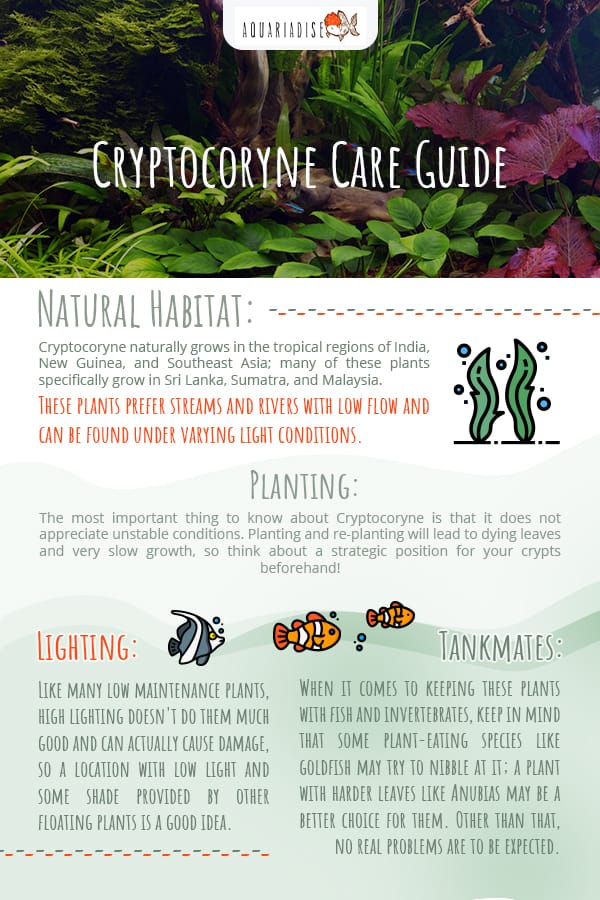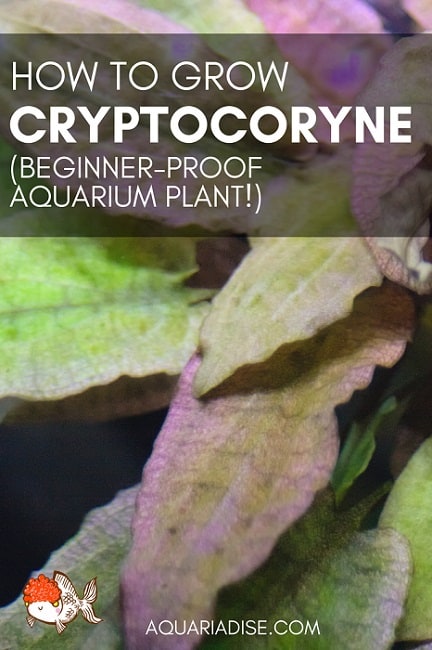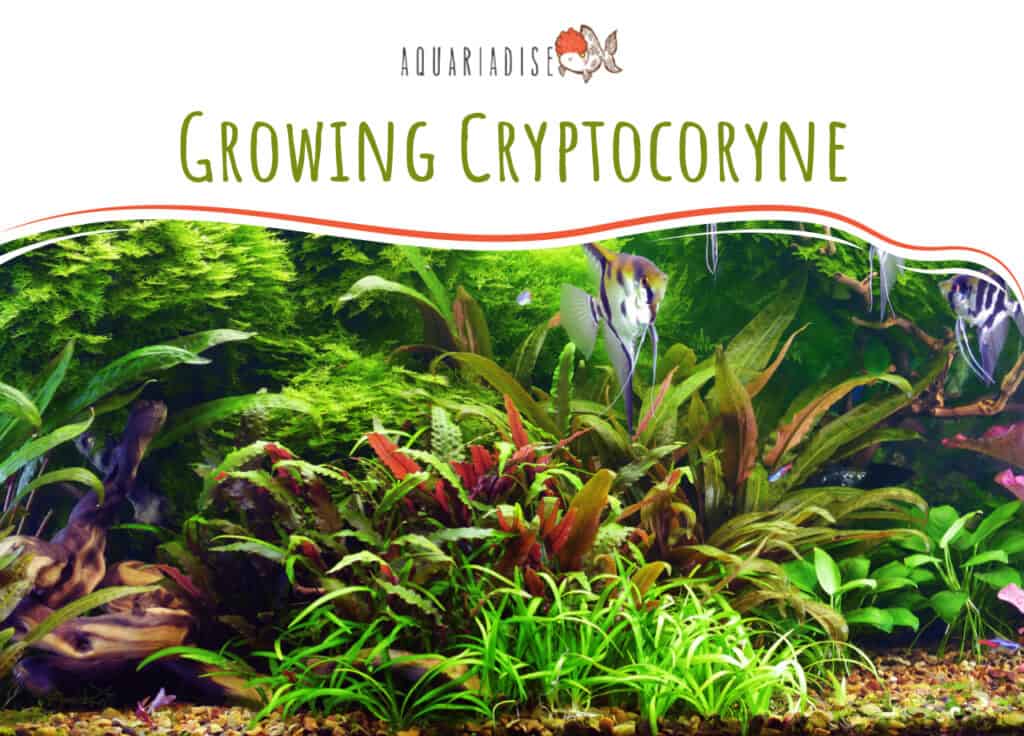Plants from the genus Cryptocoryne, usually referred to as ‘crypts’ by aquarists, are one of the easiest aquatic plants to keep. This, combined with the fact that they are available in many different color varieties that all look beautiful without needing special care, makes them one of the most popular plant species in the hobby today!
Keep reading for more information about Cryptocoryne care and growing it in your own aquarium.
| Minimum recommended tank size | N/A |
| Care level | Easy |
| Placement | Mid-/background |
| Temperature | 68-83 °F/20-28 °C |
| pH | 6-7.5 |

Name
Cryptocoryne is a genus of the freshwater plants containing nearly a hundred species. They are an Angiosperm, meaning they produce flowers and fruits that give way to seeds. The first species of this plant was described in 1779 by Anders Jahan Retzius.
Natural Habitat
Cryptocoryne naturally grows in the tropical regions of India, New Guinea, and Southeast Asia; many of these plants specifically grow in Sri Lanka, Sumatra, and Malaysia. These plants prefer streams and rivers with low flow and can be found under varying light conditions. They are also found in seasonal areas that are affected by tides and rainfall, like forest pools and river banks.
Identification
With so many species, it can be difficult to exactly identify your new aquarium plant. However, you are likely to come across C. wendtii, C. spiralis, and C. crispatula, which are relatively easy to identify from each other:
- C. wendtii: can grow up to 6 inches (15 cm) and has green or reddish-brown leaves; the leaf is long and in a tear-drop shape and connects to a long stem.
- C. spiralis: can grow well over a foot (30) in height, with tall and slender leaves.
- C. crispatula: can grow even taller than C. spiralis, and has very long and thin leaves with ruffled edges, which connect to a short stem.
Planting
The most important thing to know about Cryptocoryne is that it does not appreciate unstable conditions. Planting and re-planting will lead to dying leaves and very slow growth, so think about a strategic position for your crypts beforehand!
Like many low maintenance plants, high lighting doesn’t do them much good and can actually cause damage, so a location with low light and some shade provided by other floating plants is a good idea. The best placement depends on which kind of crypt you’re dealing with: some will stay relatively small and will look better in the foreground or middle of the aquarium, while some will become very tall, surpassing 20 inches (50 cm), and are great to use in the background.
Once you’ve figured out the perfect position for your crypts you can just plant them in sand or gravel substrate and you’re done! Like many other aquarium plants, they will do best with an enriched substrate and many sources consider this a necessity. I’ve personally found that these plants don’t need the extra iron to survive, but skipping it can definitely slow down growth.

Care & tankmates
- Once you’ve planted your new Cryptocoryne, there isn’t much else you need to do; they’re very easy plants! They don’t need added CO2 or lots of fertilizer to thrive, just a little patience–they usually grow quite slow, especially right after planting. Just be sure to keep your water values stable to keep the plant from getting “stressed” and shedding its leaves!
- Whether they prefer soft or slightly hard water or a low or high pH depends on where the specific species is naturally found; still, stability is more important than the actual water values and these species can get used to many types of water and light conditions. If you’re not sure, neutral pH and slightly soft water is a good place to start.
- If this stability is provided, you should see your crypts starting to grow slowly but steadily, until they eventually form a lush forest of leaves that you may actually have to trim now and then by removing their stems. If any new runners are produced, you can re-plant these or remove them to sell or give away!
- When it comes to keeping these plants with fish and invertebrates, keep in mind that some plant-eating species like goldfish may try to nibble at it; a plant with harder leaves like Anubias may be a better choice for them. Other than that, no real problems are to be expected. The advanced root systems of this plant make it difficult for fish to uproot and shy fish, fry, and dwarf shrimp will love hiding and foraging in the leaves.
Problems with Cryptocoryne
Even though crypts are relatively easy plants that do well in a wide range of conditions, there is always a possibility of running into problems. As mentioned before, stability is the key to keeping this plant healthy. If your crypts are shedding its leaves, especially right after buying, there is usually no need to worry. They may die off almost completely but should return looking extra lush and green eventually.
A common problem to face with these plants is called ‘crypt melt.’ While the exact reason for the crypt melt is unknown, there is a chance that your new plant will wither away to nothing in the first month of owning it. Some people believe that it’s due to undesirable parameters while others blame the light it is put under. If this happens to yours, there is a slight chance that it will regrow itself.
If the leaves of your plant appear pale or yellowish, you may be dealing with an iron deficiency. Working with an enriched substrate as mentioned under ‘Planting’ or adding some extra nutrients should help resolve this!
Buying Cryptocoryne
When buying one of these plants, it’s important to keep in mind that there are endless varieties of this species; way too many to discuss here!
Some species, including the most popular, Cryptocoryne. wendtii, can grow very tall especially under a light with low intensities. Others, like the ‘dwarf’ variety, C. parva, stay much smaller and work better as foreground plants. Leaf shapes and colors also vary across and even inside species: leaves can be sharp and pointed or more rounded and range in color from bright green to brown or even bright red. This means there’s a crypt for every aquarium, but make sure to definitely check the label that comes with the plant to see if it needs any specific care.
Most pet- and aquarium stores that sell aquarium plants should carry at least one or two of the species, and you shouldn’t have too much trouble finding one you like. The most popular easy crypts, as well as some of the lesser-known species, are all also available online!
If you have any more questions about growing Cryptocoryne or if you want to share your experiences with this wonderful plant, be sure to leave a comment below. Happy fishkeeping!



I have a new tank with a soil substrate and my stem plants and cryptocoryne spiralis is flourishing but my crypt wendtii, lucens and other smaller crypts are being eaten by snails (I have trumpet and bladder snails in all my tanks) even healthy leaves are being attacked and the new sprouting leaves. I’m wondering if it’s because they are adjusting to the new tank (been running for two months). Do the snails attack because they are melting? It just seems odd that even the new leaves are being attacked. This has never happened in my other tanks before.
Hi Michael!
Some hobbyists do think that some snail species (most notably, bladder snails) will eat aquarium plants, but I wouldn’t say it’s too common. For the most part, snails will stick to algae and detritus and only feed on decaying/weak leaves.
If you find that this is an ongoing problem though, it might be worthwhile feeding blanched vegetables or algae wafers once every week or so to keep your snails interested in other foods.
How many gallons of water does this plant need
Hello!
Plants only need as many gallons as needed to keep them submerged. It’s good to look up the potential adult size of the plant to get an idea of how big it will get, but even then, you can keep it trimmed. At the very least, I would recommend a couple of gallons.
I have a dirted 5-gallon tank with Flourite substrate. Should I add root tabs or will the cryptocoryne green wendtii grow just fine? I have 2 watts per gallon for my light if it matters.
Hello!
Most substrates are actually inert and don’t offer much in the way of nutrients for plants. Your lighting is a little on the lower side, which is good in your case as more light creates a higher demand for nutrients. If you have other plants, I would recommend using root tabs at this point. If used as directed, they should only help keep your plants fed.
However, crypts are slow growers and might not take up the nutrients given by the root tabs fast enough to prevent algae from growing in the tank. If all you have are crypts and they seem to be doing fine, then I would not start dosing.
Hey! I have new crypts and I have long stems growing off them with a singular leaf.. is this, good? Is that how you propogate them?
Hi Nathan!
Crypts grow in a one-leaf fashion and can have longer stems, yes. When your crypt starts to grow, you’ll notice new leaves coming up one blade at a time.
If you want to propagate your crypts, gently remove them from the substrate and separate the root systems. Each plant will have a few leaves to it, but the roots should come apart relatively easily.
Hello, my crypts starting to have holes and I’ve been cracking my head as to why. Do you have any idea or suggestions on what I should do pls?
Hi Sufian!
Holes in your plants indicate a deficiency somewhere in your tank. Usually, this is a sign of a potassium deficiency. If possible, test your potassium levels and buy supplements if need be. Some hobbyists also believe that holes can be a sign of a carbon dioxide deficiency, but I would first test the potassium instead.
Also, make sure that you don’t have any pest snails or overly-aggressive suckerfish that could be damaging your plants.
I’ll be moving soon and really want to take my plants with me. But it’ll be months maybe even a year before I’m able to set up new tanks. How long will these last in a bucket of water? And is there anything special I need to do to keep them alive? Thanks.
Hi! If you have the space you could always consider doing a nice planted vase or something similar. You could try following the instructions from the article on setting up a planted bowl which can be found here. If you can’t invest in a light you can always see if you have a nice and light (but not sunny) windowsill to place the container on instead.
Just an idea. 🙂
hi i have a crypt so will it send out runners i have a gravel subsrate so im worried the plant wont be strong enough to push out of the rocks
Hi,
Yeah, Crypts tend to multiply by runners. I wouldn’t worry too much about whether the plant will be able to push through, you’d be surprised at how strong they are! 🙂
How do you propograte them?
Hello! If you’ve got bigger clumps you can easily just separate those. The bottom part can be broken however you want it and the plantlets will continue to grow. 🙂
I have had great luck growing Crypts in my 10 gallon tank, but for some reason, after I moved some into my 36 gallon, its not growing taller than 2-3 inches, whereas in my 10 gallon, it was getting about a foot tall. I haven’t dosed ferts in my 10 gal, but I use Excel daily, Flourish weekly, and I also have added Seachem root tabs and there is still no change. I see some new growth, but nothings getting taller. It’s frustrating me lol. The leaves are all green, too, no yellow.
Any suggestions?
That’s odd! Have you compared water tests from the two tanks? It could be the nitrate levels differ or something like that. If you can test for the nutrients plants use that could be helpful too, but not all water tests include them. Good luck!